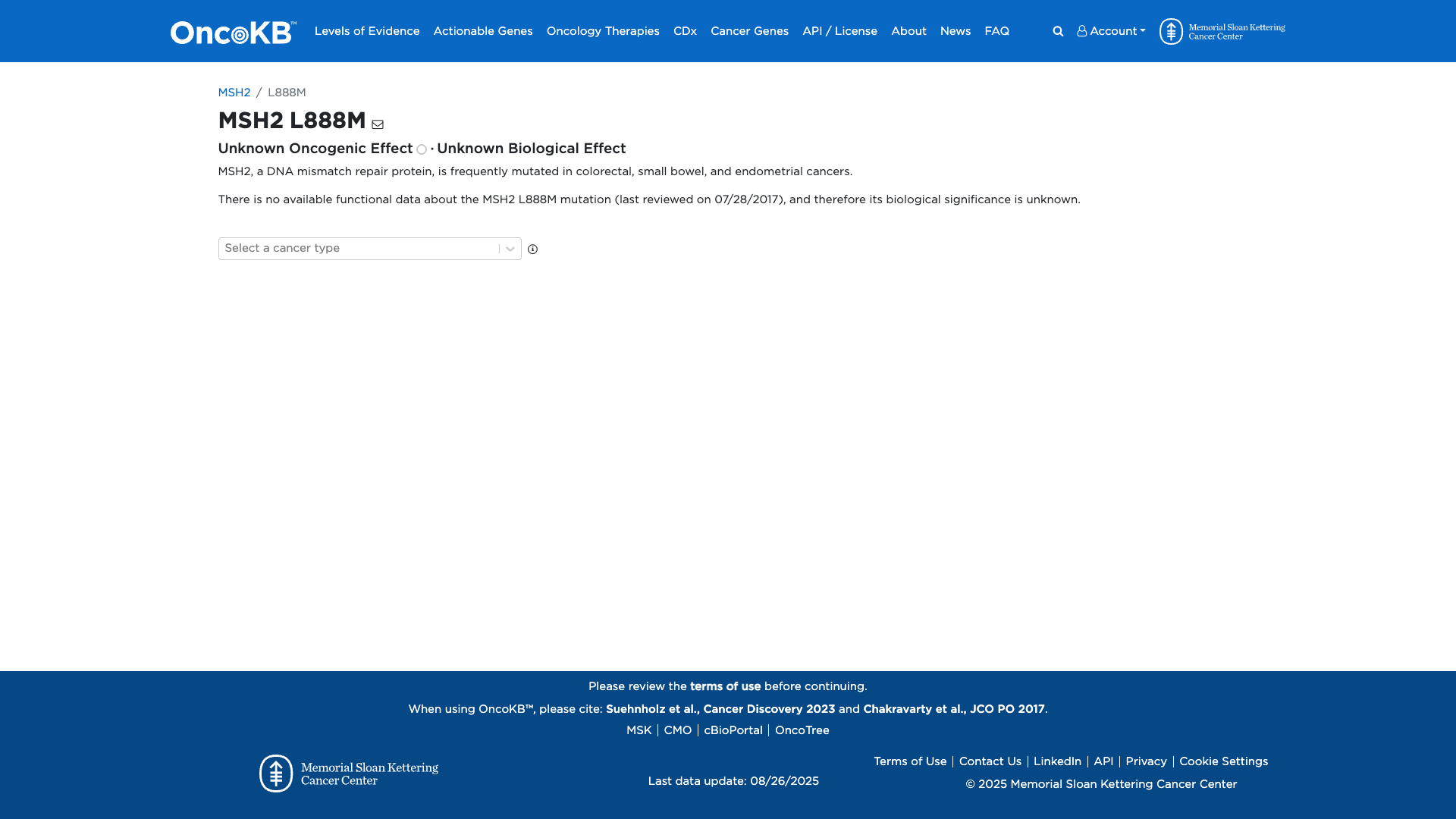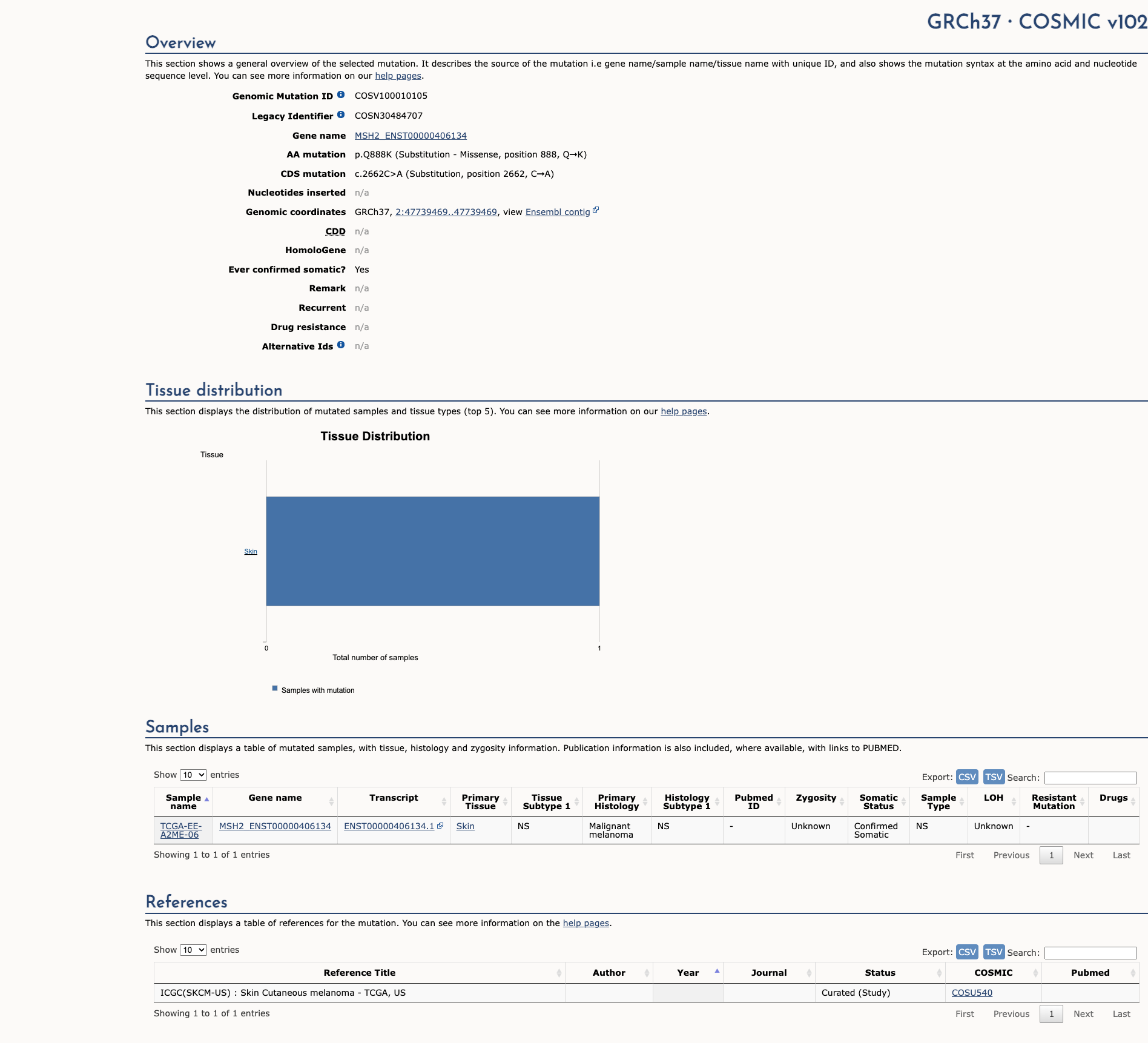MSH2 c.2662C>A, p.Leu888Met
NM_000251.2:c.2662C>A
COSMIC ID: COSM9114093, COSN30484707
Variant of Uncertain Significance (VUS)
MSH2 c.2662C>A (p.L888M) is absent from population databases (PM2_Supporting) but lacks functional, segregation, or tumor data, as well as any established pathogenic amino acid change. With only a single supporting pathogenic criterion and no benign criteria, the variant remains classified as VUS.
ACMG/AMP Criteria Applied
PM2
Genetic Information
Gene & Transcript Details
Gene
MSH2
Transcript
NM_000251.3
MANE Select
Total Exons
16
Strand
Forward (+)
Reference Sequence
NC_000002.11
Alternative Transcripts
| ID | Status | Details |
|---|---|---|
| NM_000251.2 | RefSeq Select | 16 exons | Forward |
| NM_000251.1 | Alternative | 16 exons | Forward |
Variant Details
HGVS Notation
NM_000251.2:c.2662C>A
Protein Change
L888M
Location
Exon 16
(Exon 16 of 16)
5'Exon Structure (16 total)3'
Functional Consequence
Loss of Function
Related Variants
No evidence of other pathogenic variants at position 888 in gene MSH2
Alternate Identifiers
COSM9114093, COSN30484707
Variant interpretation based on transcript NM_000251.3
Genome Browser
Loading genome browser...
HGVS InputNM_000251:c.2662C>A
Active Tracks
ConservationRefSeqClinVargnomAD
Navigation tips: Use mouse to drag and zoom. Click on features for details.
Clinical Data
Population Frequency
Global Frequency
0.0 in 100,000
Extremely Rare
Global: 0.0%
0%
0.05%
0.1%
1%
5%
10%+
ACMG Criteria Applied
PM2
This variant is not present in gnomAD (PM2 criteria applies).
Classification
Uncertain Significance (VUS)
Based on 1 submitter review in ClinVar
Submitter Breakdown
1 VUS
Pathogenic
Likely Path.
VUS
Likely Benign
Benign
Publications (0)
No publication details.
Clinical Statement
This variant has been reported in ClinVar as Uncertain significance (1 clinical laboratories).
Functional Impact
Functional Domain
Hotspot Status
Not a hotspot
Domain Summary
This variant is not located in a mutational hotspot or critical domain (0 mutations).
Related Variants in This Domain
No evidence of other pathogenic variants at position 888 in gene MSH2
Functional Summary
The MSH2 L888M variant has not been functionally characterized, and its biological significance remains unknown.
Database Previews
OncoKB

JAX-CKB

Click on previews to view full database entries. External databases may require institutional access.
Computational Analysis
Pathogenicity Predictions
REVEL Score
0.672
0.672
Likely Benign0.0
Uncertain (Low)0.2
Uncertain (Med)0.5
Likely Pathogenic0.75
REVEL scores ≥ 0.75 are strong evidence (PP3)
Predictor Consensus
Mixed/VUS
PP3 Applied
No
Additional Predictors
Pathogenic:
metasvm: Dmetalr: D
Benign:
CADD: 2.81polyphen_prediction: benignprimateai: T
Neutral: Show all
VCEP Guidelines
Applied ACMG/AMP Criteria (VCEP Specific) VCEP Guidelines
PVS1
PVS1 (Not Applied) Strength Modified
According to VCEP guidelines, the rule for PVS1 is: "Very Strong Strength: Very Strong Nonsense/frameshift variant introducing Premature Termination Codon (PTC) ≤ codon 891 in MSH2. Refer to Appendix for details." The evidence for this variant shows it is a missense substitution (L888M), not a null variant. Therefore, PVS1 is not applied.
PS1
PS1 (Not Applied) Strength Modified
According to VCEP guidelines, the rule for PS1 is: "Strong Strength: A predicted missense substitution that encodes the same amino acid change with a different underlying nucleotide change previously established by this VCEP as Pathogenic (not a predicted or confirmed splice defect)." The evidence for this variant shows no previously established pathogenic L888M at the protein level. Therefore, PS1 is not applied.
PS2
PS2 (Not Applied) Strength Modified
According to VCEP guidelines, the rule for PS2 is: "Very Strong Strength: ≥ 4 de novo points; Strong Strength: 2 or 3 de novo points; Moderate Strength: 1 de novo point; Supporting Strength: 0.5 de novo points." No de novo data are available for this variant. Therefore, PS2 is not applied.
PS3
PS3 (Not Applied) Strength Modified
According to VCEP guidelines, the rule for PS3 is: "Strong Strength: Calibrated functional assays with functional odds for Pathogenicity > 18.7; Moderate Strength: Calibrated functional assays with odds >4.3 and ≤18.7; Supporting Strength: Calibrated functional odds >2.08 and ≤4.3." No functional assay data exist for L888M. Therefore, PS3 is not applied.
PS4
PS4 (Not Applied) Strength Modified
According to standard ACMG guidelines, the rule for PS4 is: "The prevalence of the variant in affected individuals is significantly increased compared with controls." No case-control or cohort data are available. Therefore, PS4 is not applied.
PM1
PM1 (Not Applied) Strength Modified
According to standard ACMG guidelines, the rule for PM1 is: "Located in a mutational hot spot and/or critical and well-established functional domain without benign variation." L888 is not known to be in a mutational hotspot or critical functional domain. Therefore, PM1 is not applied.
PM2
PM2 (Supporting) Strength Modified
According to VCEP guidelines, the rule for PM2 is: "Supporting Strength: Absent/extremely rare (<1 in 50,000 alleles) in gnomAD v4 dataset." The evidence for this variant shows it is absent from gnomAD and other population databases. Therefore, PM2 is applied at Supporting strength.
PM3
PM3 (Not Applied) Strength Modified
According to VCEP guidelines, the rule for PM3 is: "Very Strong Strength: ≥ 4 points; Strong Strength: ≥ 2 and < 4 points; Moderate Strength: ≥ 1 and < 2 points; Supporting Strength: 0.5 points (for autosomal recessive inheritance)." MSH2 causes an autosomal dominant condition (Lynch syndrome), so PM3 is not applicable. Therefore, PM3 is not applied.
PM4
PM4 (Not Applied) Strength Modified
According to standard ACMG guidelines, the rule for PM4 is: "Protein length changes due to in-frame deletions/insertions or stop-loss variants not in repetitive regions." L888M is a missense substitution without length change. Therefore, PM4 is not applied.
PM5
PM5 (Not Applied) Strength Modified
According to VCEP guidelines, the rule for PM5 is: "Moderate Strength: Missense change at an amino acid residue where a different missense change was classified by this VCEP as Pathogenic." No other pathogenic missense at residue 888 has been reported. Therefore, PM5 is not applied.
PM6
PM6 (Not Applied) Strength Modified
According to VCEP guidelines, the rule for PM6 is: "Supporting Strength: 0.5 de novo points for unconfirmed de novo occurrence." No de novo information is available. Therefore, PM6 is not applied.
PP1
PP1 (Not Applied) Strength Modified
According to VCEP guidelines, the rule for PP1 is: "Strong Strength: Co-segregation with disease in pedigree(s) with Bayes LR > 18.7; Moderate Strength: Bayes LR > 4.3 and ≤ 18.7; Supporting Strength: Bayes LR > 2.08 and ≤ 4.3." No segregation data are available. Therefore, PP1 is not applied.
PP2
PP2 (Not Applied) Strength Modified
According to standard ACMG guidelines, the rule for PP2 is: "Missense variant in a gene with a low rate of benign missense variation and where missense is a common mechanism of disease." MSH2 has both truncating and missense pathogenic variants, so missense is not uniquely informative. Therefore, PP2 is not applied.
PP3
PP3 (Not Applied) Strength Modified
According to VCEP guidelines, the rule for PP3 is: "Moderate Strength: Missense variant with HCI prior probability > 0.81; Supporting Strength: HCI prior > 0.68 and ≤ 0.81 OR predicted splice defect with SpliceAI delta ≥ 0.2." No HCI prior probability is provided and SpliceAI delta is 0.05 (<0.2). Therefore, PP3 is not applied.
PP4
PP4 (Not Applied) Strength Modified
According to VCEP guidelines, the rule for PP4 is: "Strong Strength: ≥ 3 independent CRC/Endometrial MSI-H tumors in ≥ 2 families; Moderate Strength: 2 independent tumors; Supporting Strength: 1 tumor with consistent loss of MMR protein." No tumor or MSI/IHC data are available. Therefore, PP4 is not applied.
PP5
PP5 (Not Applied) Strength Modified
According to standard ACMG guidelines, the rule for PP5 is: "Reputable source recently reports variant as pathogenic." ClinVar reports this variant as VUS. Therefore, PP5 is not applied.
BA1
BA1 (Not Applied) Strength Modified
According to VCEP guidelines, the rule for BA1 is: "Stand Alone Strength: GnomAD v4 Grpmax filtering allele frequency ≥ 0.001 (0.1%)." The variant is absent from gnomAD. Therefore, BA1 is not applied.
BS1
BS1 (Not Applied) Strength Modified
According to VCEP guidelines, the rule for BS1 is: "Strong Strength: GnomAD v4 Grpmax filtering allele frequency ≥ 0.0001 and < 0.001 (0.01–0.1%)." The variant is absent from population databases. Therefore, BS1 is not applied.
BS2
BS2 (Not Applied) Strength Modified
According to VCEP guidelines, the rule for BS2 is: "Strong Strength: Co-occurrence in trans with a known pathogenic variant in the same gene in a patient with LS cancer and no CMMRD." No co-occurrence data are available. Therefore, BS2 is not applied.
BS3
BS3 (Not Applied) Strength Modified
According to VCEP guidelines, the rule for BS3 is: "Strong Strength: Calibrated functional assays with functional odds for Pathogenicity ≤ 0.05 OR synonymous/intronic variants with no mRNA aberration." No functional or mRNA assay data exist. Therefore, BS3 is not applied.
BS4
BS4 (Not Applied) Strength Modified
According to VCEP guidelines, the rule for BS4 is: "Strong Strength: Lack of co-segregation with disease in pedigree(s) with Bayes LR < 0.05; Supporting Strength: LR > 0.05 and ≤ 0.48." No segregation data are available. Therefore, BS4 is not applied.
BP1
BP1 (Not Applied) Strength Modified
According to standard ACMG guidelines, the rule for BP1 is: "Missense variant in a gene for which primarily truncating variants cause disease." MSH2 has known pathogenic missense variants. Therefore, BP1 is not applied.
BP2
BP2 (Not Applied) Strength Modified
According to standard ACMG guidelines, the rule for BP2 is: "Observed in trans with a pathogenic variant for a fully penetrant dominant gene." No such co-occurrence data are present. Therefore, BP2 is not applied.
BP3
BP3 (Not Applied) Strength Modified
According to standard ACMG guidelines, the rule for BP3 is: "In-frame deletions/insertions in a repetitive region without a known function." L888M is a missense substitution. Therefore, BP3 is not applied.
BP4
BP4 (Not Applied) Strength Modified
According to VCEP guidelines, the rule for BP4 is: "Supporting Strength: Missense variant with HCI prior probability < 0.11 OR for intronic/synonymous variants: SpliceAI delta ≤ 0.1." No HCI prior was provided and L888M is missense. Therefore, BP4 is not applied.
BP5
BP5 (Not Applied) Strength Modified
According to standard ACMG guidelines, the rule for BP5 is: "Variant found in a case with an alternate molecular basis for disease." No alternate molecular basis is reported. Therefore, BP5 is not applied.
BP6
BP6 (Not Applied) Strength Modified
According to standard ACMG guidelines, the rule for BP6 is: "Reputable source reports variant as benign." No such report exists. Therefore, BP6 is not applied.
BP7
BP7 (Not Applied) Strength Modified
According to VCEP guidelines, the rule for BP7 is: "Supporting Strength: A synonymous or intronic variant at or beyond -21/+7." L888M is a missense coding change. Therefore, BP7 is not applied.

